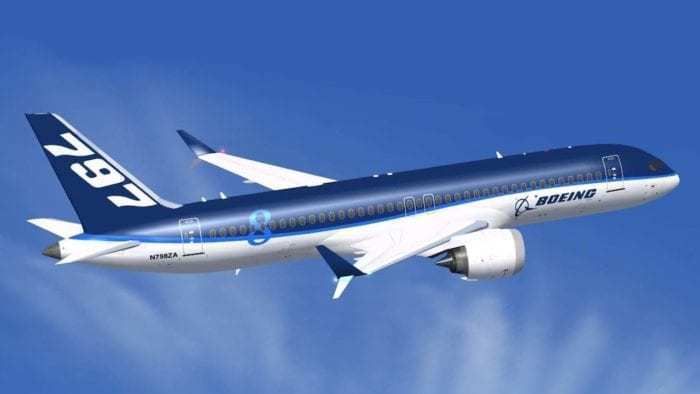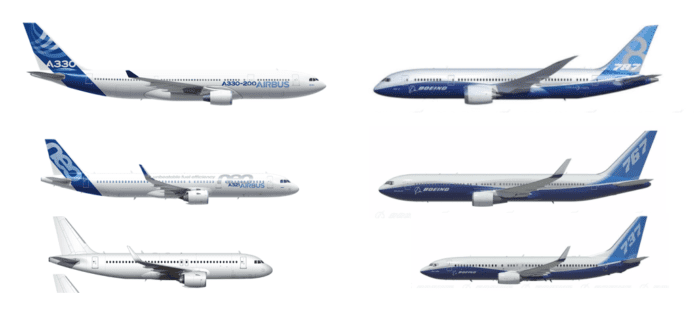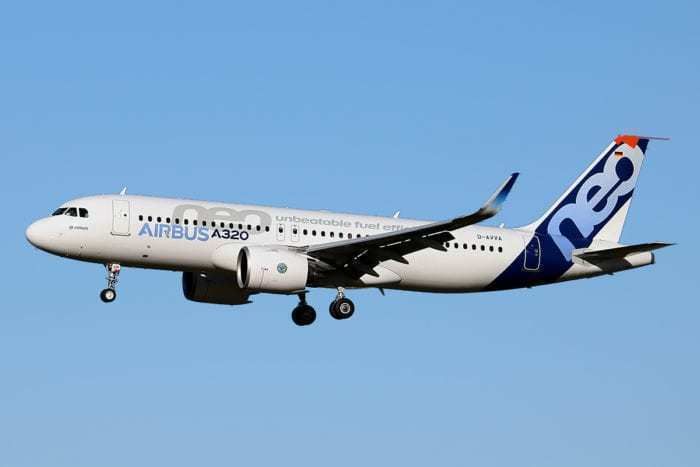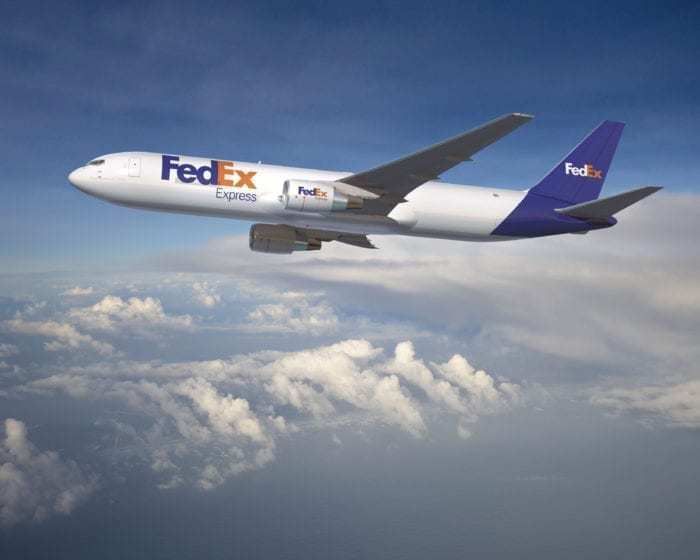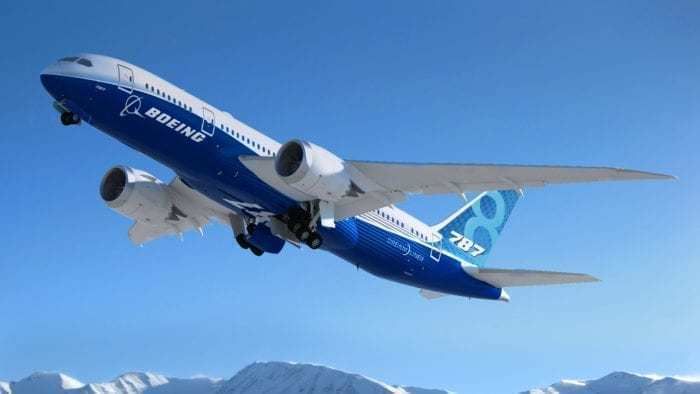We may get the first glimpse of the Boeing 797 at the upcoming Paris Air Show. But, until then, we can only speculate on how Boeing will approach the current aviation market, and how they will deal with competition.
Engine manufacturer Rolls Royce is predicting 4,000-5,000 Boeing 797s will be ordered over the next 20 years. But what aircraft will the 797 be competing against, and will this competition be able to beat Boeing to the punch?
What is the Boeing 797?
Before we can discuss what aircraft will compete with the 797, we should explain exactly what role the 797 will fill.
The Boeing 797, also dubbed the 'New Midsized Aeroplane', fills a hole in the Boeing aircraft lineup. Currently, Boeing does not sell an aircraft that carries up to 250-270 passengers and is designed for short haul travel. The Boeing 797 would be bigger than the Boeing 737 MAX 10 but smaller than the long haul Boeing 787-8.
Airlines are looking for an aircraft that is suited for high capacity short-haul routes. Routes between large and close cities such as Melbourne and Sydney (the most passengers per year) or Chicago and New York could benefit from the 797. With its twin aisles, it will be able to board and disembark passengers much faster than the single aisle aircraft currently used on these routes, such as the Boeing 737 or Airbus A320.
The 797 has the advantages of being a new design and incorporating the latest technological innovations from both the Dreamliner and the Boeing 777x, which will be flying later this year. These include a composite structure to make it lighter and a myriad of improved passenger comforts.
For those curious, here are the rumored specifications:
|
Boeing 797 |
|
|
Cockpit crew |
Two |
|
Seating |
228 (2-Class) up to 275 (1-class) |
|
Exit Limit (Total possible passengers) |
250-270 |
|
Length |
155 ft 3 in / 47.3 m (Boeing 757) |
|
Wingspan |
124 ft 10 in / 38.0 m span |
|
Wing area |
1,994 sq ft (185.25 m2) area |
|
Tail height |
44 ft 6 in / 13.6 m |
|
Cabin width |
Around 4-5 meters wide (2x2x2 configuration) |
|
Maximum takeoff weight |
Unknown at this time |
|
Cruising Speed |
Possibly Mach 0.85 |
|
Fuel capacity |
Around 11,000 US gal |
|
Range |
5,000 nmi (9,300 km) |
Naturally, all of the above specifications are subject to change and only estimations.
What aircraft will the 797 compete with?
There are a variety of different aircraft on the market that the Boeing 797 will be competing against.
There are some that are already in use and some future designs that could be tweaked to be a 797 killer. We have listed a few below:
Here they are side by side, with the Boeing 797 in the middle.
|
Aircraft |
Passengers |
Range |
Cost |
|
A320 |
186 |
3,300 nmi |
US$101M |
|
737 MAX 10 |
~200 |
3,000 nmi |
US$134.9M |
|
797 |
228-275 |
5,000 nmi |
US$100M |
|
A321neo |
240 |
4,000 nmi |
US$129.5 million |
|
787-8 |
242 |
7,355 nm |
US$239.0M |
|
767-300ER |
260-290 |
5,980 nmi |
US$217.9M |
|
A330-800 |
257-400 |
8,150nm |
US$259.9M |
|
787-9 |
290 |
7,635 nm |
US$281.6M |
Airbus A320 / Boeing 737
Currently, the role of the 797 is fulfilled (unpractically) by Airbus A320s and Boeing 737s.
The Airbus A320 has the world's fastest growing sales of any aircraft and is widely used. But both of these aircraft are smaller (fitting in around 100-230 passengers) and lack the advantages of a newer twin-aisled design.
Boeing has said that the 737 could perform much of the work, but a further stretch is nearly impossible. The reason for this is that the design is already so long that would scratch the ground as it took off, and any bigger engines would clip the ground (the 737 was designed for stairways in mind, and is too low to the ground to really be practical for bigger loads).
The Boeing 737 has also been involved in some unfortunate accidents that have highlighted how out of date the design is, and that Boeing needs to approach the market with a brand new concept.
Boeing 767
The Boeing 767 is the closest jet to what the 797 will become. It is twin-aisled, carrying 210-300 passengers with a range of 5,500-6,500 nmi. Boeing produced and sold over 1,200 of these aircraft and they are still in use all over the world. However, it's an older design made for a time when flights were much more expensive, fuel was cheap and building materials were heavy. With lighter and more fuel efficient planes available, the Boeing 767 is just not the most economical option on the market.
With the Boeing 797 unlikely to be flying before 2024, it's possible that Boeing could restart Boeing 767 production in the meantime. It is believed that United is looking for around 40 mid-sized aircraft to bridge the gap, for instance. They could simply convert the freighter variants under construction. Currently, Boeing leadership have ruled it out, but anything is possible.
Airbus A321neo
In a previous article, we compared the Airbus A321neo (the biggest and most advanced version of the Airbus A320 family) to the upcoming Boeing 797. Airbus has come out and said that they intend either this aircraft or the Airbus A330neo to compete with the Boeing 797.
However, the A321 can only carry around 230 passengers (exit limit 250) and only has a range of 4-5,000 nmi. This would always make it the lesser option when compared to the 797. But Airbus isn't worried, knowing that it will reap plenty of orders that might go to a 797 .
"We don't feel under pressure to react, even before Boeing has moved," Airbus CEO said earlier this month "Market share for the A321 is very big because there's no real competition, and we'll keep improving this product to serve the low end of the middle-of-market space."
Boeing 787-8
The Boeing 787-8 seems to tick all the boxes for the Boeing 797. It is twin-aisled, economical, carries 242 passengers in a two-class configuration 7,300 nmi. But this is overkill for some airlines. As we have mentioned before, a bigger plane means more tickets to sell. More tickets to sell means it is harder to make a profit.
Plus Boeing would not want to cannibalize sales of their own aircraft and thus will differentiate the 797 from the 787 family. It is unlikely that they would market it as an option.
Airbus A330neo
The last aircraft on this list is the actual aircraft Airbus is officially touting to beat the 797. specifically the A330-800, which has only sold eight units in the world.
The A330-800 can carry 257 passengers (3 class configuration) or up to 400 in an all-economy cattle box. It has a range of 8,150 nmi and would place it perfectly within the scope of what Boeing is trying to achieve. The only problem is cost. The Airbus A330-800 is expensive to buy ($259.9 million) and run. The Boeing 797 is rumored to be priced around $120 million and to run 40% cheaper than the A330. So far the fact that Airbus has only sold eight A330-800s is very telling of how popular this design is.
But Airbus has not ruled out tweaking the design, so we shall have to see what the future holds for this aircraft.
When will the Boeing 797 design be finished?
As for when we actually will be flying in the Boeing 797, that is up to Boeing:
“We’re not going to launch this airplane unless the business case makes good sense, We still have time to do our homework and make the right decision, so we’re not going to be rushed into a decision here.” – Boeing
What do you think? Let us know in the comments.


